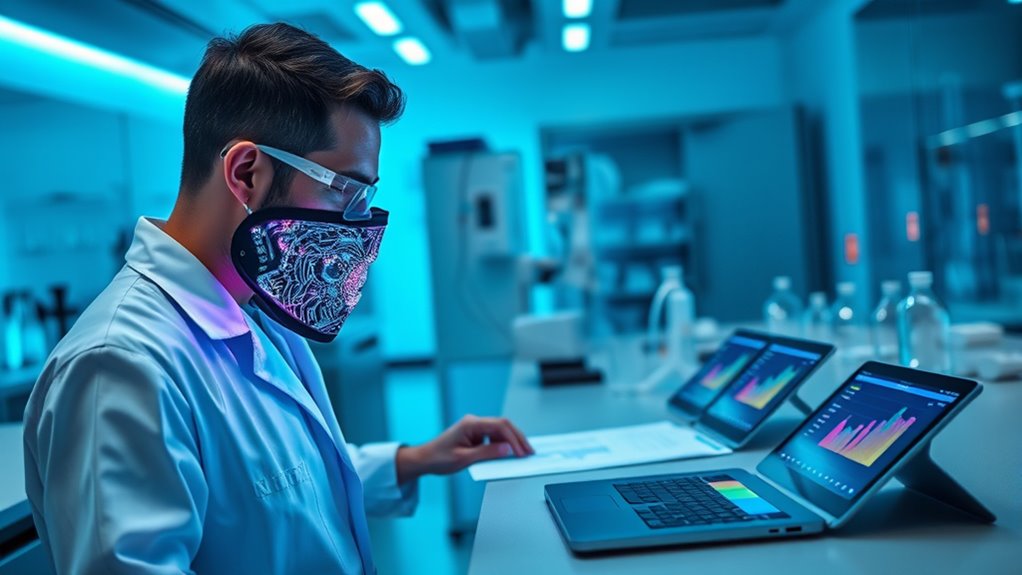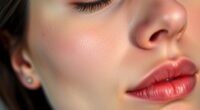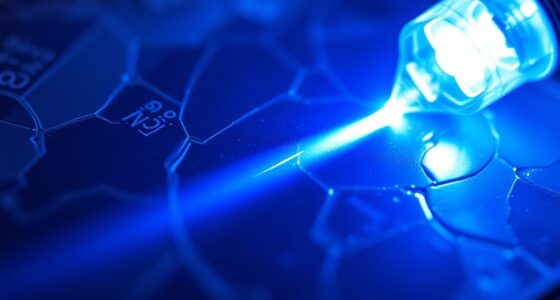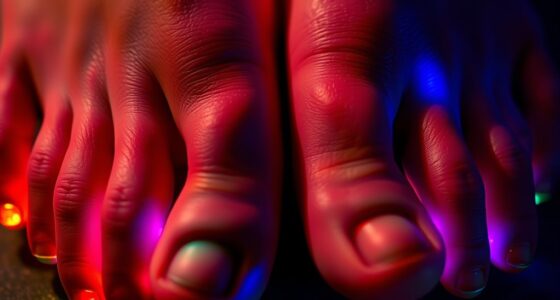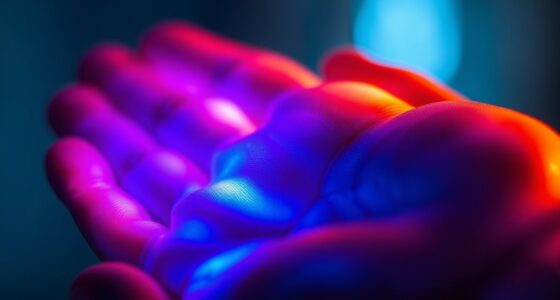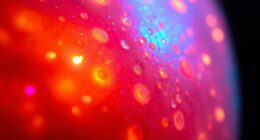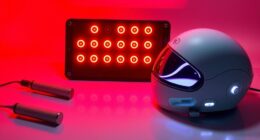Understanding the key clinical studies on LED masks helps you see how these devices are proven to improve skin health. These trials assess safety, effectiveness, and specific skin concerns like aging or acne. They often involve volunteers and carefully measure improvements in texture, firmness, and elasticity. Knowing these studies reassures you about the devices’ credibility and results. Continue exploring to discover the five essential studies every LED-mask owner should be familiar with.
Key Takeaways
- Clinical trials verify LED masks’ safety and effectiveness through rigorous, controlled studies before market approval.
- Key studies assess improvements in skin texture, firmness, elasticity, and patient satisfaction across diverse skin types.
- Research identifies optimal treatment parameters, including light wavelengths and session durations, for targeted skin concerns.
- Trials monitor for side effects like redness or irritation, ensuring consumer safety and device reliability.
- Published clinical results enhance transparency, build consumer trust, and support regulatory approval of LED skincare devices.
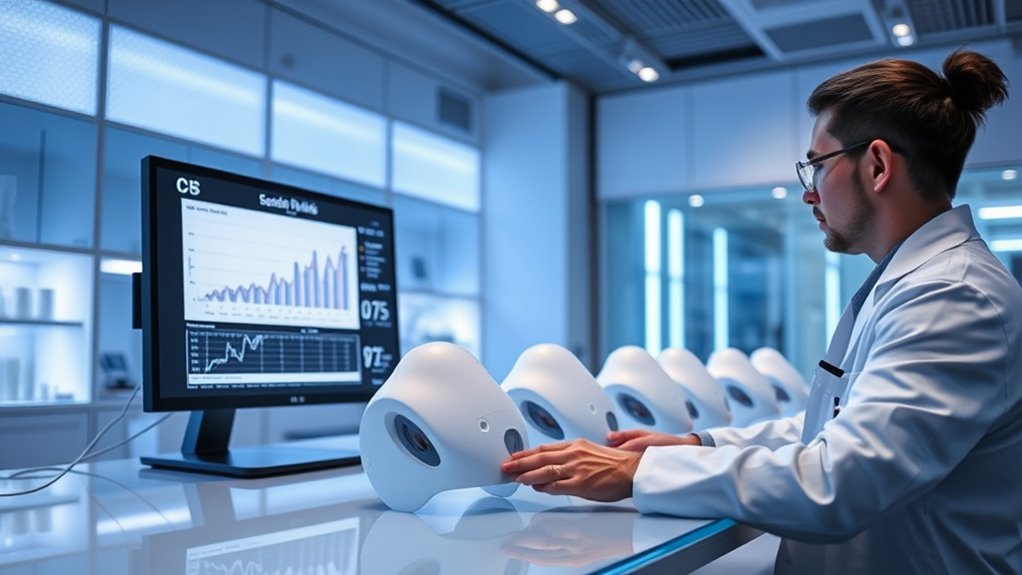
Ever wondered how new medical treatments are tested before reaching patients? This process involves rigorous clinical trials designed to guarantee safety and effectiveness. For those interested in skincare, especially LED therapy, understanding how these trials work can be eye-opening. LED therapy, often used for skin rejuvenation, has gained popularity for its non-invasive approach to improving skin appearance. But before it hits the shelves or your favorite spa, it undergoes a series of carefully controlled studies. These clinical trials evaluate not only whether LED therapy works for skin rejuvenation but also if it’s safe for regular use. You might wonder, how do researchers determine that? They recruit volunteers, administer the treatment, and then monitor the outcomes closely, looking for improvements and any adverse reactions. This process can take months or even years, but it’s essential for establishing the credibility of new skin treatments.
When it comes to skin rejuvenation, clinical trials focus on several key factors. Researchers measure changes in skin texture, firmness, and elasticity, comparing baseline conditions to post-treatment results. They also assess patient satisfaction and look out for side effects, which might include redness, irritation, or more serious reactions. These studies are meticulously designed to eliminate biases and guarantee reliable data. By doing so, they help confirm that LED therapy genuinely delivers on its promise to enhance skin health and appearance. As a potential user or advocate of LED masks, knowing that these treatments have undergone thorough testing can boost your confidence in their safety and efficacy.
Furthermore, clinical trials provide critical insights into how different skin types respond to LED therapy. They help identify optimal treatment protocols—such as light wavelengths and session durations—tailored for specific concerns like aging, acne, or pigmentation issues. This scientific validation is what separates a reputable skincare device from a fad. Manufacturers often publish trial results to demonstrate their product’s effectiveness, and regulatory agencies review these findings before granting approval. As an LED-mask owner, understanding this process can help you make informed decisions and appreciate the science behind skin rejuvenation at home.
Frequently Asked Questions
Are LED Masks Suitable for All Skin Types and Tones?
You might wonder if LED masks suit all skin types and tones. While they’re generally safe, skin tone compatibility varies, and LED masks have limitations. Certain wavelengths may work better for specific concerns or skin tones, so it’s essential to select a device designed for your needs. Always consult a skincare professional to guarantee the LED mask’s benefits outweigh any limitations for your skin type and tone.
How Long Should I Wait to See Results From LED Mask Use?
While patience is key, you might start noticing subtle signs of skin rejuvenation after about 4 to 6 weeks of consistent LED therapy. Everyone’s skin responds differently, so don’t get discouraged if results take a bit longer. Regular use promotes healthy cell turnover, gradually revealing improved texture and tone. Keep at it, and with time, your skin will thank you for the gentle boost from LED therapy.
Can LED Masks Be Used Alongside Skincare Products Safely?
You can generally use LED masks safely alongside your skincare products, but check device compatibility first. Some products, like serums or creams with active ingredients, might interact with the light therapy or cause irritation. To keep your skincare routine effective, apply products after LED sessions or follow the manufacturer’s guidelines. Always patch-test new products and consult your dermatologist if you’re unsure about combining treatments.
What Are the Potential Side Effects or Risks of LED Mask Therapy?
Imagine stepping into a gentle dawn, but beware—LED mask therapy can have side effects like skin irritation or discomfort if overused. You might also face eye safety concerns if the light isn’t properly shielded or used incorrectly. While many enjoy its benefits, it is crucial to follow instructions carefully and limit exposure to avoid potential risks, ensuring your skin and eyes stay safe and healthy during your skincare journey.
How Does the Cost of LED Mask Treatments Compare to Clinical Options?
When comparing the cost of LED mask treatments to clinical options, you’ll find that LED masks are generally more affordable and offer better treatment affordability for daily use. Clinical treatments tend to be more expensive due to professional fees and multiple sessions. A cost comparison shows that investing in an LED mask can save you money over time while still providing effective skincare. This makes LED masks an attractive, budget-friendly alternative for ongoing skin health.
Conclusion
Now that you know the facts behind these studies, it’s clear that LED masks may offer real benefits, but they’re not magic cures. Don’t fall for hype—research shows results vary, and some claims are overstated. Approach with a critical eye, and remember, consistency and realistic expectations matter most. Trust in science, but stay cautious—your skin’s health deserves honest, evidence-based care. Make informed choices, and embrace a skincare routine backed by facts.
